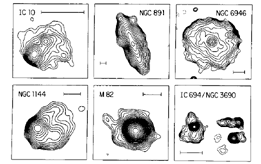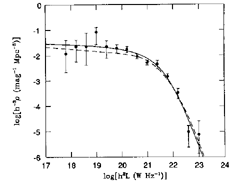Copyright © 1992 by Annual Reviews. All rights reserved
| Annu. Rev. Astron. Astrophys. 1992. 30:
575-611 Copyright © 1992 by Annual Reviews. All rights reserved |
Radio sources exist in nearly all normal spiral and dwarf irregular
galaxies, in many peculiar or interacting systems, and even in a small
number of E/SO galaxies with ongoing star formation (Dressel 1988;
Wrobel & Heeschen 1988, 1991). Unbiased samples of these
sources reveal the types of sources to be found; the range of luminosities,
sizes, brightnesses, morphologies, spectra, etc. that they span; and
their similarities and differences. Normal galaxies range in power
from L ![]() 10
18 h
-2 W Hz -1 to L ~ 10 23 h
-2
W Hz -1 at
10
18 h
-2 W Hz -1 to L ~ 10 23 h
-2
W Hz -1 at  = 1.49 GHz,where h
= 1.49 GHz,where h  H0 / (100 km s -1 Mpc
-1). The total brightness of the fainter extended
sources in normal galaxies is not much larger than the rms brightness
fluctuation produced by discrete background sources, so confusion is a
serious observational problem. All spiral and irregular galaxies
brighter than the BT = 12 limit for 100% completeness of
the Revised Shapley-Ames Catalog (Sandage
& Tammann 1981) and north of
H0 / (100 km s -1 Mpc
-1). The total brightness of the fainter extended
sources in normal galaxies is not much larger than the rms brightness
fluctuation produced by discrete background sources, so confusion is a
serious observational problem. All spiral and irregular galaxies
brighter than the BT = 12 limit for 100% completeness of
the Revised Shapley-Ames Catalog (Sandage
& Tammann 1981) and north of
 = -45° have
been mapped at 1.49 GHz by the VLA with
= -45° have
been mapped at 1.49 GHz by the VLA with  ~
0´.9 FWHM resolution; most were detected (Condon 1987). Since the FIR
and radio luminosities of normal galaxies are tightly correlated,
flux-limited samples of normal galaxies selected at FIR and radio
wavelengths are nearly identical. The largest and most complete is
the IRAS Revised Bright Galaxy Sample (Soifer et al. 1989) of 313
extragalactic sources stronger than S = 5.24 Jy at
~
0´.9 FWHM resolution; most were detected (Condon 1987). Since the FIR
and radio luminosities of normal galaxies are tightly correlated,
flux-limited samples of normal galaxies selected at FIR and radio
wavelengths are nearly identical. The largest and most complete is
the IRAS Revised Bright Galaxy Sample (Soifer et al. 1989) of 313
extragalactic sources stronger than S = 5.24 Jy at  = 60 µm. Multiconfiguration VLA maps
at 1.49 GHz (Condon et al. 1990)
detected all but one, and 8.44 GHz maps with 0".25 FWHM resolution
(Condon et al. 199lc) resolved most of
the sources not already resolved at 1.49 GHz. Large samples of radio
sources in normal galaxies have also been generated by
position-coincidence identifications of sources found in general radio
surveys with optically-selected UGC (Nilson 1973) galaxies (Condon & Broderick 1988, Condon et al. 1991b). Radio sources
powered by
monsters in active galactic nuclei (AGNs) can be excluded on the basis
of radio morphology FIR spectral index
= 60 µm. Multiconfiguration VLA maps
at 1.49 GHz (Condon et al. 1990)
detected all but one, and 8.44 GHz maps with 0".25 FWHM resolution
(Condon et al. 199lc) resolved most of
the sources not already resolved at 1.49 GHz. Large samples of radio
sources in normal galaxies have also been generated by
position-coincidence identifications of sources found in general radio
surveys with optically-selected UGC (Nilson 1973) galaxies (Condon & Broderick 1988, Condon et al. 1991b). Radio sources
powered by
monsters in active galactic nuclei (AGNs) can be excluded on the basis
of radio morphology FIR spectral index  (25
µm, 60 µm) < 1.5 (de
Grijp et al. 1985, 1987) and
FIR / radio flux density ratio (Condon &
Broderick 1988). Direct radio identifications of faint FIR-selected
galaxies (Condon & Broderick 1986, 1991) also yield complete, but
small, samples of radio sources in normal galaxies. The FIR- and
radio-selected samples of ``normal'' galaxies favor luminous starbursts
and contain a large proportion of disturbed, peculiar and interacting
systems.
(25
µm, 60 µm) < 1.5 (de
Grijp et al. 1985, 1987) and
FIR / radio flux density ratio (Condon &
Broderick 1988). Direct radio identifications of faint FIR-selected
galaxies (Condon & Broderick 1986, 1991) also yield complete, but
small, samples of radio sources in normal galaxies. The FIR- and
radio-selected samples of ``normal'' galaxies favor luminous starbursts
and contain a large proportion of disturbed, peculiar and interacting
systems.
Figure 2 illustrates the
range of radio sizes and morphologies seen in
normal galaxies. The faintest dwarf irregulars have radio luminosities
comparable with the Galactic SNR Cassiopeia A and little or no detectable
emission extending beyond known H II regions and SNRs. Their radio
morphologies are lumpy and irregular (see IC 10 in
Figure 2), and their
radio spectra are often relatively flat (Klein & Gräve 1986). The thick
radio disk / halo of the edge-on galaxy NGC 891 and the fairly smooth
radio disk with bright spiral arms of the face-on galaxy NGC 6946 are
typical of the larger spiral galaxies. The central radio sources in normal
galaxies like NGC 6946 are brighter but usually much less luminous than
the disk sources and it is no longer thought that they are significant
sources of disk cosmic rays. Luminous radio sources with complex
morphologies may be found in colliding galaxies (e.g. NGC 1144). There is a
tendency for fairly compact (diameter D ![]() 1 kpc) central starbursts to
dominate at higher radio luminosities, as in M82. The most luminous radio
sources in normal galaxies are frequently quite compact, D ~ 200 pc
(Condon et al. 1991c), and confined to
the nuclei of strongly interacting
(Condon et al. 1982, Hummel et al. 1990) systems (e.g.
IC 694+NGC 3690).
Hybrid Nbody / gasdynamics simulations show that a prograde collision
involving a disk galaxy can drive about half of the disk gas (
1 kpc) central starbursts to
dominate at higher radio luminosities, as in M82. The most luminous radio
sources in normal galaxies are frequently quite compact, D ~ 200 pc
(Condon et al. 1991c), and confined to
the nuclei of strongly interacting
(Condon et al. 1982, Hummel et al. 1990) systems (e.g.
IC 694+NGC 3690).
Hybrid Nbody / gasdynamics simulations show that a prograde collision
involving a disk galaxy can drive about half of the disk gas ( ![]() 10 10
M
10 10
M  )
within 200 pc of the nucleus (Hernquist
1989, Barnes & Hernquist 1991),
where the gas density becomes quite high before a powerful starburst is
triggered (Kennicutt 1989). The
resulting massive stars and their SNRs then produce intense radio
emission.
)
within 200 pc of the nucleus (Hernquist
1989, Barnes & Hernquist 1991),
where the gas density becomes quite high before a powerful starburst is
triggered (Kennicutt 1989). The
resulting massive stars and their SNRs then produce intense radio
emission.
 Figure 2. Contour maps (Condon 1987,
Condon et al. 1990) illustrating
the range of source morphologies,
sizes, and luminosities found in normal galaxies. The bars are
2h-1 kpc long. The logarithmic contours are separated
by 21/2 in brightness, and the 1.49 GHz brightness
temperatures Tb of the lowest contours are 0.25 K
(IC 10, NGC 891, NGC 6946), 0.5 K (M82), 8 K (NGC 1144), and 128 K (IC 694+NGC 3690).
Figure 2. Contour maps (Condon 1987,
Condon et al. 1990) illustrating
the range of source morphologies,
sizes, and luminosities found in normal galaxies. The bars are
2h-1 kpc long. The logarithmic contours are separated
by 21/2 in brightness, and the 1.49 GHz brightness
temperatures Tb of the lowest contours are 0.25 K
(IC 10, NGC 891, NGC 6946), 0.5 K (M82), 8 K (NGC 1144), and 128 K (IC 694+NGC 3690).
The 1.49 GHz local luminosity function of normal galaxies (Condon
1989) specifies the differential number of normal galaxies per Mpc
3 per magnitude (factor of 10 0.4) of 1.49 GHz
luminosity (Figure 3). The
FIR / radio
correlation (see Figure 8 later)
ensures that the FIR and radio
luminosity functions have the same form. The dashed line in Figure 3 is
the  = 60 µm luminosity function
(Saunders et al. 1990) directly
transformed to 1.49 GHz assuming only
<(log(S60 µm / S1.49
GHz)> = 2.24 from
Figure 8. If the radio
sources in normal galaxies evolve on cosmological
time scales (implying higher star-formation rates in the past), they may
account for the inflection in the normalized radio source counts below
S ~ 1 mJy at 1.49 GHz (Condon 1989)
and a significant fraction of the
discrete source background (Condon 1989
). The
= 60 µm luminosity function
(Saunders et al. 1990) directly
transformed to 1.49 GHz assuming only
<(log(S60 µm / S1.49
GHz)> = 2.24 from
Figure 8. If the radio
sources in normal galaxies evolve on cosmological
time scales (implying higher star-formation rates in the past), they may
account for the inflection in the normalized radio source counts below
S ~ 1 mJy at 1.49 GHz (Condon 1989)
and a significant fraction of the
discrete source background (Condon 1989
). The  = 60 µm faint source counts are consistent with the radio
counts and evolution of normal galaxies (Lonsdale et al. 1990).
= 60 µm faint source counts are consistent with the radio
counts and evolution of normal galaxies (Lonsdale et al. 1990).
 Figure 3. The 1.49 Ghz local luminosity
function of normal spiral and irregular galaxies (data points and
solid line) is indistinguishable from their
Figure 3. The 1.49 Ghz local luminosity
function of normal spiral and irregular galaxies (data points and
solid line) is indistinguishable from their  = 60 µm luminosity function scaled to 1.49 GHz if
= 60 µm luminosity function scaled to 1.49 GHz if
 (mag-1 Mpc-3).
(mag-1 Mpc-3).